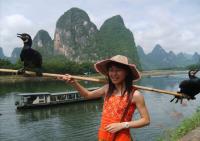Mount Heng
Mount Heng, one of the Five Sacred Mountains in ancient Chinese history, is also called Chang Mountain. It is located in Hun Yuan County of Shanxi Province, 62 km from Datong City. From east to west, the mountain stretches around 150 km, and traverses through Shanxi and Hebei provinces. The Xuanyu Peak, the highest peak, is 2,016.8 meters above sea level. In Daoism, Mount Heng is the fifth grotto heaven among The Thirty-six Lesser Grotto Heavens. It is called the General Mysterious Grotto Heaven. The mountain has 18 picturesque scenic spots, which provide a peaceful atmosphere to the visitors. Climbing up the Mount Heng, you'll see the wonderful views of green pines, luxuriant cypresses, sea of clouds, beautiful gorges, rare flowers and grasses, strange rocks, quiet caves, Buddhist and Taoist temples, towers, and pavilions.
In history, Many emperors like the First Emperor of the Qin Dynasty (221 BC - 207 BC), Emperor Wudi of the Western Han Dynasty (202 BC - 9 AD), Emperor Taizong of the Tang Dynasty (618 - 907) and Emperor Taizu of the Northern Song Dynasty (960- 1127) once visited Mount Heng and offered sacrifices. Mount Heng was coveted by all strategists since the Spring and Autumn Annals (770 BC - 476 BC) because of its steep shape and geography. As a result, a great many ruins like passes, castles, and beacon towers related to the ancient battle fields are preserved.
Some Main Tourist Attractions in the Mount Heng
Northern Temple
The earliest temple on Mt. Heng was the Northern Temple (Beiyue Temple), built in 435. It was destroyed several times throughout history, and changed into a bedroom palace. It enshrines the Great Emperor of the Northern Marchmount.
Out of the bedroom palace, there is White Cloud Hall (i.e., Official Receiving Pavilion) where officials stopped for food and rest. To the East side is Mysterious Well Pavilion. West of Mysterious Well Pavilion is Ten Kings Hall, Horse God Hall and decorated archway. The Purple Tenuity Pavilion is in the North, and the Three Maos Hole is above the Purple Tenuity Pavilion. It is said that this is the site where the Three Mao Perfect Sovereign Brothers (Sanmao Zhenjun ) attained the Dao.
Chunyang Temple
The Chunyang Temple is above the Horse God Hall and enshrines Immortal Master Chunyang. Going upward, there is Nine Heavens Temple enshrining the statue of Mysterious Maiden of the Nine Heavens. There is Cloud Reaching Pavilion and Big Dipper Mother Pavilion in the north, Mountain God Temple and Sore God Temple in the south, and Supreme Oneness Temple in the East.
Hengzong Temple
The main temple on Mount Heng is the Hengzong Temple, located on a cliff of Hengzong Peak. Hengzong Peak is also called True Origin Temple, Original Spirit Temple while common people refer to it as Pilgrim Temple. It was built in 1501 to enshrine the golden statue of Great Emperor of the Northern Mountain. Many inscribed boards are collected in it. There is an iron Cloud Board made in the Yuan (1271-1368) in its front and several stone tablets outside, which are very valuable for the study of Daoism's history on the Northern Marchmount.
Immortal Gathering Cliff
The cliff northwest of Hengzong Temple is called Immortal Gathering Cliff. At its waist, there is a platform in a hollow; people built an Immortal Gathering Mansion that is also called Immortals Collection Mansion. There are lifelike immortals of eight caverns. The Jade Emperor Pavilion and Imperial Tablets Pavilion were built besides the Immortal Hall. Two sides of the cliff are full of stone inscriptions eulogizing the beauty of Mount Heng by celebrities in history. Immortal Gathering Mansion is the highest building on Mount Heng Standing here, with the clouds floating under your feet and the wind in the pine trees resounding above your head, the mountain peaks occasionally appearing and disappearing in the clouds, one will be reluctant to leave.
Hanging Temple
The most famous temple at Mount Heng is the Hanging Temple (aka Hanging Monastery). The temple stands at the foot of Mount Heng and is one of the most dramatic sights at Mount Heng - a wooden temple clinging to the cliff side, appearing to defy gravity with only a few wooden posts as support. The Hanging Temple, built in 491, has survived more than 1,400 years. The extant temple was largely rebuilt and maintained in the Ming Dynasty (1368-1644) and Qing Dynasty (1644-1911). The buildings were restored in 1900 and there are 40 wooden halls and structures linked by an ingenious system of pillars, posts and walkways.














